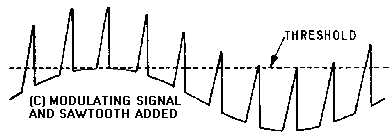2-45
Figure 2-43E.—Pulse-time modulation (ptm). PFM
PULSE-DURATION MODULATION.—Pdm and pwm are designations for a single type of
modulation. The width of each pulse in a train is made proportional to the instantaneous value of the
modulating signal at the instant of the pulse. Either the leading edges, the trailing edges, or both edges of
the pulses may be modulated to produce the variation in pulse width. Pdm can be obtained in a number of
ways, one of which is illustrated in views (A) through (D) in figure 2-44. A circuit to produce pdm is
shown in figure 2-45. Adding the modulating signal [figure 2-44, view (A)] to a repetitive sawtooth [view
(B)] will result in the waveform shown in view (C). This waveform is then applied to a circuit which
changes state when the input signal exceeds a specific threshold level. This action produces pulses with
widths that are determined by the length of time that the input waveform exceeds the threshold level. The
resulting waveform is shown in view (D).
Figure 2-44A.—Pulse-duration modulation (pdm). MODULATING SIGNAL.
Figure 2-44B.—Pulse-duration modulation (pdm). REPETITIVE SAWTOOTH PULSES.
Figure 2-44C.—Pulse-duration modulation (pdm). MODULATING SIGNAL AND SAWTOOTH ADDED.







